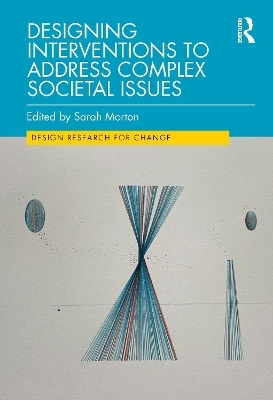
Designing Interventions to Address Complex Societal Issues
Routledge (Verlag)
978-1-032-22001-7 (ISBN)
The book documents the realities of developing and designing interventions for real people, in a real-world context. The topics covered in the book are multi-disciplinary, and include examples from health and wellbeing, education, and agriculture. The contributors provide open and honest accounts of the challenges and restrictions, highlighting the positive impact that can be gained from involving stakeholders as key voices in the intervention development process. These case studies suggest underpinning methodologies that will support the formalisation of these design-led approaches, permitting the formation of robust frameworks in the future.
The book will be of interest to scholars working in design, design research, intervention design, co-design, user-centred design, service design, digital design, digital healthcare, and evidence-based design.
Sarah Morton is a senior academic at the University of Edinburgh. She is a design engineer and ethnographer, and uses participatory, shared decision making and co-design approaches to develop interventions.
PART I Overview / introduction
1. Introduction – using design-led approaches to design with people: an overview of the realities in practice
Sarah Morton
PART II: Design-led approaches for intervention development
SECTION A: Design-led health interventions
2. Person-centred technology for independent living: designing individualised participation-focused interventions
Duncan Pentland, Julie King, and Gail Carin-Levy
3. Co-designed or evidenced based? Developing digital self-management interventions for long-term conditions
Claire McCallum, Miglena Campbell, Kate Hackett, and John Vines
4. Targeted Design for a Specialist Working Population: how Farm Vets Inform the Design of Web-based Interventions That Support Coping
Kate Lamont and Andrew Duncan
5. Take a stand for workplace health: designing sit-stand desk interventions to reduce sitting and increase physical activity
Jennifer Hall and Louise Mansfield
6. Designing innovation for health: The role of problem framing in Uganda
Leigh-Anne Hepburn
7. Towards a shared understanding of genuine co-design with people with lived experience: reflections from co-designing for relational and transformational experiences in health and social care in the UK
Sneha Raman and Tara French
8. Designing with predictive models: situating the Covid Aware app in Jamaica
Larissa Pschetz , Arlene Bailey, Jonathan Rankin, Jessica Enright, and Marisa Wilson
SECTION B: Design-led Lifestyle Interventions
9. An e-Laboratory Designed to Enhance Learning Opportunities through Experience
William James Morton
10. Futuring the Entrepreneur: design as a Pedagogic Catalyst within Sustainable Entrepreneurship Learning
George Jaramillo and Joseph Lockwood
11. Design-led approaches for responding to behaviour change: in the context of adventure sport
Sarah Morton
12. Make Space for Girls: Designing Greenspace and Other Public Spaces to Reflect the Needs of Teenage Girls
Amanda Seims, Susannah Walker, Imogen Clark, and Sufyan Abid Dogra
13. Designing beyond Tokenism: transdisciplinary Collaboration within the Academy
Leigh-Anne Hepburn
PART III: Cross-cutting learning and what next…
14. Reflections on Chapters 2-13: what can we learn from existing multi-disciplinary practice, and what next?: toward a framework for design-led practice for designing complex interventions to address societal issues
Sarah Morton, William James Morton
| Erscheinungsdatum | 02.09.2022 |
|---|---|
| Reihe/Serie | Design Research for Change |
| Zusatzinfo | 10 Halftones, color; 30 Halftones, black and white; 10 Illustrations, color; 30 Illustrations, black and white |
| Verlagsort | London |
| Sprache | englisch |
| Maße | 174 x 246 mm |
| Gewicht | 453 g |
| Themenwelt | Kunst / Musik / Theater ► Design / Innenarchitektur / Mode |
| Kunst / Musik / Theater ► Kunstgeschichte / Kunststile | |
| ISBN-10 | 1-032-22001-5 / 1032220015 |
| ISBN-13 | 978-1-032-22001-7 / 9781032220017 |
| Zustand | Neuware |
| Informationen gemäß Produktsicherheitsverordnung (GPSR) | |
| Haben Sie eine Frage zum Produkt? |
aus dem Bereich


